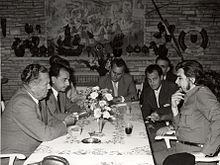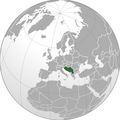Cuba–Yugoslavia relations were historical foreign relations between Cuba and now split-up Socialist Federal Republic of Yugoslavia. Official diplomatic relations were established in 1943 when the Yugoslav government-in-exile decided to upgrade its consulate into an official representation office.[1]
Cuba |
Yugoslavia |
|---|---|

During the Cold War both countries actively participated in the work of the Non-Aligned Movement in which they belonged to different informal sub-groupings and often disagreed on the common policies of the movement. Cuba associated mostly with self-described progressive members which advocated for what they perceived as natural identity of interest between Soviet socialism and colonial people of Africa and Asia. Post 1948 Tito-Stalin split Yugoslavia on the other hand identified with self-described movement's core members which insisted on strict equidistance towards both blocs. Both approaches aimed to achieve strategic independence from one or the other superpower. This disagreement reached its peak at the time of the 1979 Summit in Havana.[2][3]
Despite significant disagreements on the question of Soviet strategic alliance and competition for influence within the movement, both countries insisted on maintaining courteous and close relations on the level of state protocol. On his goodwill mission to Afro-Asian countries and Yugoslavia Che Guevara visited Belgrade, Kragujevac, Sarajevo, Rijeka, Opatija and Brijuni islands in 1959, eight months after the Cuban revolution.[4] Fidel Castro visited Yugoslavia it in 1976.[1][5] President of Yugoslavia Josip Broz Tito visited Havana at the time of 1979 Non-Aligned Summit which was his last international trip.
Country comparison
edit| Common name | Cuba | Yugoslavia |
|---|---|---|
| Official mame | Republic of Cuba | Socialist Federal Republic of Yugoslavia |
| Coat of arms | ||
| Flag | ||
| Capital | Havana | Belgrade |
| Largest city | Havana | Belgrade |
| Population | 9,729,896 (1982) | 23,229,846 (1991) |
| Government | Unitary Marxist-Leninist one-party socialist republic | Federal socialist republic |
| Official languages | Spanish | No official language
Serbo-Croatian (de facto-state wide) Slovene (in Slovenia) and Macedonian (in Macedonia) |
| First leader | Tomás Estrada Palma | Josip Broz Tito |
| Last leader | Fidel Castro | Milan Pančevski |
| Religion | State atheism (official) | Secular state (de jure), state atheism (de facto) |
| Alliances | Comecon | Non-Aligned Movement |
See also
editReferences
edit- ^ a b Marina Perović. "Izlaganje ambasadora Marine Perović Petrović povodom 70. godišnjice uspostavljanja diplomatskih odnosa Srbije i Kube, augusta 1943". The Embassy of the Republic of Serbia in Havana. Retrieved 23 February 2021.
- ^ Lily Lynch (29 November 2016). "The Tito – Castro Split and the End of Cigar Socialism". Balkanist. Retrieved 23 February 2021.
- ^ Michael Dobbs (29 August 1979). "Tito Sees Soviet Threat to Nonaligned". Washington Post. Retrieved 23 February 2021.
- ^ Nataša Anđelković (24 August 2020). "Če Gevara, Tito i Jugoslavija - o čemu su pričali i šta je sve El komandante video i doživeo u zemlji koja je danas prošlost". BBC. Retrieved 23 February 2021.
- ^ Ronald D. Landa, ed. (1991). Foreign Relations of the United States: Diplomatic Papers (Volume VI: Cuba). United States Government Printing Office. p. 590.

